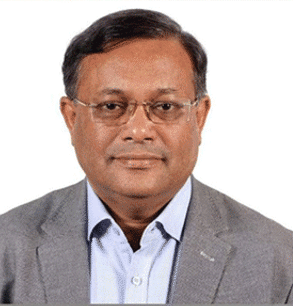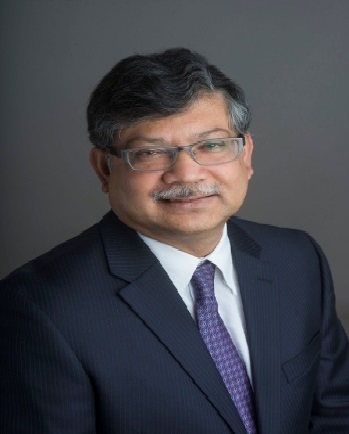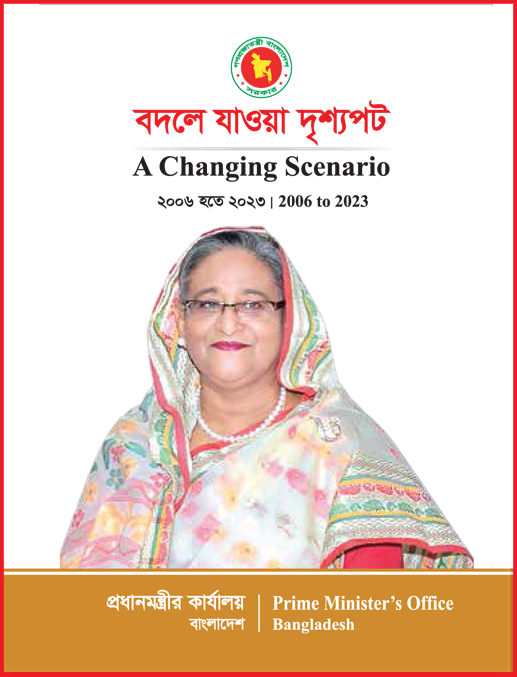H.E. Mr.ShahriarAlam, MP, Hon’ble State Minister forForeign Affairs,Government of the People’s Republic ofBangladeshat the Conference on ‘VNR 2020 of Bangladesh: Positioning Non-StateActors’Dhaka, 11 March 2020
Dr. Debapriya Bhattacharya,
Ms. Rasheda K Chodhury,
Mr. Zakir Hossain,
Ms. Orla Murphy,
Dr. Mohammad Khairul Alam,
Mr. Sudipto Mukerjee,
Excellencies,
Ladies and Gentlemen,
Good Morningand assalamu alaikum.
I am very happy to join all of you today. I express my sincere appreciation to the ‘Citizen’s Platform for SDGs’ for arranging this conference. I am truly delighted to see that recognized experts, authorities, academicians and civil society personalities are engaged to review our forthcoming Voluntary National Review in next July. I am sure that all of us will be benefitted from their wisdom and experience to better and faster achieve SDGs for Bangladesh.
Distinguished guests,
Bangladesh is celebrating the 100th birth anniversary of our Father of the Nation Bangabandhu Sheikh Mujibur Rahman and the golden jubilee of our glorious independence next year, which is a rare occasion in our national history. Inspired by these auspicious occasions, our government is committed to the people to realize fully the Vision 2021 and Vision 2041 as gifts. In between these Visions, the achievement of SDGs by 2030 will further add to our already declared determination and decision of having a prosperous, peaceful but strong Bangladesh as dreamt by our Father of the Nation. Our current election manifesto also makes a pledge to the people to achieve all these goals for the benefit of the people.
Dear Friends,
Since its independence Bangladesh has come a long way. Our unique impressive economic achievements in recent years, under the visionary leadership of Bangabandhu’s accomplished daughter, Prime Minister Sheikh Hasina, have been well recognized at home and abroad. From a ‘bottomless basket’ in early Seventies, Bangladesh today is a development miracle. Since 2009, with the highest growth rate in the Asia Pacific at 8.15%, Bangladesh’s economy has grown by 188% in size. Our per-capita income has surpassed $1,909. Bangladesh’s brillianteconomic performance has led it to graduate to a lower-middle-income nation in 2015. In 2018, Bangladesh further had a turning point when it met the United Nation’s criteria for graduating from the "least developed country" status by 2024. However, this is only the beginning and we need to make this accomplishment a sustainable and permanent one.
Ladies and gentlemen,
All of you remember well that in 2015, world leaders agreed to 17 goals with 169 targets and 232 indicators for building a better world by 2030. If achieved, these goals will end poverty, fight inequality and address the urgency of climate change. Guided by the goals, it is now the responsibility of all of us: governments, businesses, civil society and the general public to work together to build a better future for everyone. However, the Government of the Prime Minister Sheikh Hasina was already working with MDGs and after achieving most of them, she had set even higher targets by declaring the Vision 2021, Vision 2030 and the Vision 2041. All the ‘5 year’ plans and the Perspective Plan were developed to implement these Visions. Likewise, the 2030 Agenda is very wellembedded in the successive national 5 year plans. To achieve the 2030 Agenda, the Government from the very beginning adopted a “whole of society” approach for implementation and attainment of the SDGs.Our discussion today is a testimony of this ‘whole of the society’ approach of the government.Especially for the preparation of the VNR in July 2020, different Ministries held several consultations on stakeholders’ engagement on SDGs implementation involving representatives from the NGOs, CSOs, Business community, Development Partners, Ethnic Minorities, professional groups, labour associations, women groups and media. We hope that as suggested by UN, we will be able to prepare the draft VNR as per UN format by second week of April, 2020. Then the National SDG Task Team will sit with CSOs and other stakeholders to finalize the report. So we are having two intense engagements with CSO to prepare and submit our VNR this year.
However, Excellencies,
It will not be an overstatement if we briefly remember the actions and measures taken by the government for the effective achievement of the SDGs.We have clearly mapped the responsibilities of the different ministries and agencies in the process. GED conducted a review of the data gap in the country based on 232 indicators suggested by the UN Statistical Commission. The government prepared a “National Action Plan for SDGs Implementation” in accordance with the objectives of the 7th Five Year Planand asked all relevant ministries for preparation of their respective implementation plan. The government has carried out an exercise to estimate the financing needs for SDGs implementation with a view to mobilizing internal and external resources. The report estimates that an additional amount of USD 928.48 billion at 2015-16 constant prices would be required for SDGs implementation during the period of FY 2017-FY 2030, which is 19.75 per cent of the accumulated GDP. The annual average additional fund required for SDGs would be USD 66.32 billion (at 2017 constant prices) for this period. Five potential sources of gap financing have also been identified. They are: Private Sector, Public Sector, Public-Private Partnership (PPP), External source which include foreign direct investment (FDI) and Foreign Aid and Grants and finally the Non-Government Organization (NGO). On average, public sector would account for around 34% of the financing requirement, whereas private sector has the share of around 42% during 2017-30 period. The average share of PPP is 6%. The external sources have an average share of around 15% where the share of FDI is 10% and that of foreign aid is 5%. Finally, the NGOs would contribute around 4% for the same period. This means that to deliver SDGs, non-state actors will have to provide 66% of the financial resources for achievements of SDGs in Bangladesh. That’s why I again thank the organizers for highlighting the importance of the non-state actors today by having this important conference. I hope that the wise men present here would further shed light on this important issue of financing which has emerged as the main impediment to achieve the SDGs.
Ladies and gentlemen,
To continue with the efforts of the government, let me mention that the Monitoring and Evaluation (M&E) Framework of SDGs has been developed based on the data available. The M&E Framework provides baseline data for relevant indicator and milestone targets to attain for the 2020, 2025 and finally 2030 of the SDGs. In addition, Bangladesh has designed SDG Tracker, an innovative tool that helped creating a dashboard showing latest available data on indicators in real time. Learning from the experience of MDGs, we have integrated the goals of the SDGs into our ongoing 7th Five Year Plan and are incorporating in the upcoming 8th Five Year Plan for 2021-2025 and the Perspective Plan of 2021-2041. General Economics Division (GED) has put forwarded a draft framework for localization of SDGs and we have come up with 39 +1 format for all districts and smaller administrative units. Bangladesh had participated in the Voluntary National Review (VNR) of SDGs in 2017 and as we all know is going to participate again this year. In this connection I will appreciate the efforts and laborthat went into producing these two volumes of reports produced by the Citizen’s Platform. There might be difference of opinion on many conclusions of the reports and I hope that the successes of the government and the people are also aptly reflected in these two reports. I am sure the authors of the reports have taken into consideration the present and future constrains and challenges and serious lack of resources while the prepared the reports.
Dear friends,
I see that‘Non-state Actors’ (NSAs) in implementations of the SDGs were mentioned in the reports as the private sector, non-government developmental organisations (NGOs), community based organisations (CBOs) and civil society organisations (CSOs). This is a comprehensive definition which once again reminds us that 66% of the total finance for the SDGs will come from Non-state Actors. So their importance in realization of these goals can hardly be over emphasized. These non-state actors are engaged with issues under all 17 goals that we are going to cover during our VNR. They are always a key player in social development. While the private sector is slowly making a noticeable contribution recently towards achieving the SDGs, they are yet to fully align their activities with goals and targets of the global agenda. However, it is heartening to see that, more and more private sector entities are becoming aware of the urgency to adhere to the needs of the SDGs. CSOs, usually, are working more at smaller levels. It is good to notice that both the private commercial as well as non-profit sectors are showing sensitivity to the new global demands for investment in areas, such as climate change, decent work, institutional accountability, eradication of poverty and hunger, non-discrimination, health and food security which are critical to realizing the SDGs. Under the circumstances, a stable and functional working relationship between the government and the non-state actors based on mutual respect is absolutely necessary for the effectiveness of collaborative efforts related to SDG implementation.
Distinguished guests,
The reports rightly mention that efforts are needed to be taken at national and global levels for meeting up the existing data gap through more primary surveys on a regular basis. It is also true that the CSOs need the support of the government for scaling up their activities on SDG implementation but here I would also hope that they would also understand the limitations of the Government and its various machineries. The government strongly recognize the role of the non-state actors at the official level and consider them as partners in the institutional framework for SDG implementation in Bangladesh. We expect that they would help to share the good practices adopted by the government. I am happy to see that subsequent sessions today would mainly focus on the Youth and different civil rights. I hope that the distinguished guests would provide practicable solutions and advices for better implementation of the strategies and policies to achieve all 17 SDGs appreciating the good accomplishments of the government as per requirement of the VNR.
Ladies and gentlemen,
At the end, it is proved that the role of non-state actors, is always critical in setting up Bangladesh’s strategic choices to reach the achievement of SDGs by 2030 along with smooth and sustainable LDC graduation by 2024 and becoming a developed country by 2041. Against the rising backdrop of the 50th anniversary on one hand and the future challenges on the other hand, we need stronger partnership between government and the private sector, civil society and non-governmental organizations. This partnership is crucial to ensure that we continue to build on our past development gains and these gains can be sustained and become even more dynamic and inclusive. I again thank the organizers for their efforts and contribution and for having me here to share our mutual ideas and experience.
Thank you.
Joy Bangla, Joy Bangabandhu.













